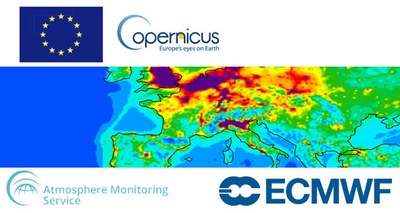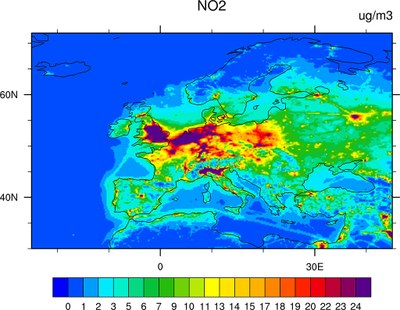Environment: ENEA enters EU Copernicus Programme for air quality forecasting
23/5/2019
 ENEA enters the EU Copernicus programme for monitoring air pollution with the Modeling System MINNI, with the task of contributing to the forecasting of the composition of the atmosphere in Europe, collaborating with nine other models developed by European research institutes. The system MINNI[1] will develop maps of air concentration levels of particulates (PM10 and PM2.5) and gases (sulfur dioxide, nitrogen dioxide, carbon monoxide and ozone) and later of pollen (grass, birch, olive and ambrosia) and secondary components of PM2.5.
ENEA enters the EU Copernicus programme for monitoring air pollution with the Modeling System MINNI, with the task of contributing to the forecasting of the composition of the atmosphere in Europe, collaborating with nine other models developed by European research institutes. The system MINNI[1] will develop maps of air concentration levels of particulates (PM10 and PM2.5) and gases (sulfur dioxide, nitrogen dioxide, carbon monoxide and ozone) and later of pollen (grass, birch, olive and ambrosia) and secondary components of PM2.5.
“As of today, ENEA is the only Italian presence in the Copernicus Atmosphere Monitoring Service. Currently, our task is to develop simulations in line with those of the other partners, working to improve the overall forecast. Later on, MINNI could become an operational model in all respects", Luisella Ciancarella, Head of the ENEA air pollution laboratory, said. Thanks to the project Copernicus Atmosphere Monitoring Service (CAMS 50), it will be possible to obtain increasingly realiable 4-day forecasts of the concentrations of atmospheric pollutants, accurate and for "tailored" time intervals; in fact, in order to improve the performance of the models, for each forecast day the analysis of the data observed the previous day will be performed, while a second analysis will be carried out on the data already validated and referring to the two previous years.
 FORAIR_IT (FORecast AIR quality over ITaly), the Italian air quality forecasting system with unique temporal and spatial detail capacity, was born from this model, used to conduct a posteriori evaluations of national policies on air pollution: it currently provides 3-day pollutant concentrations forecasting, with a resolution of 4 km2 in Italy (the size of a small municipality) and 20 km2 in Europe.
FORAIR_IT (FORecast AIR quality over ITaly), the Italian air quality forecasting system with unique temporal and spatial detail capacity, was born from this model, used to conduct a posteriori evaluations of national policies on air pollution: it currently provides 3-day pollutant concentrations forecasting, with a resolution of 4 km2 in Italy (the size of a small municipality) and 20 km2 in Europe.
The system MINNI was developed by ENEA to simulate the behavior of pollutants in the atmosphere, producing hourly maps of concentration of gases and particulates, particularly fine particles.
"MINNI is a powerful tool sheddding light on the nature of the phenomenon of air pollution, when and why it occurs, with a resolution never reached before in Italy; the application of these same modeling components to the FORAIR_IT forecasting system has created the basis for becoming part of the Copernicus Atmosphere Monitoring Service Program” Mario Adani, ENEA researcher and project scientific director, pointed out.
MINNI will make use of the CRESCO6 super computer at the ENEA Research Center in Portici (Naples), which recently entered the prestigious TOP500 list of the world's most powerful supercomputers, thanks to the doubling of its power to 1.4 million billion arithmetic operations per second (1.4 PetaFlops).
The Copernicus Atmosphere Monitoring Service (CAMS), managed by the European Center for medium-term weather forecasts (European Center Medium Weather Forecast - ECMWF), is one of the 6 services of the EU Copernicus program [2] offering information services on air pollution, health, greenhouse gases and climate, based on acquired and integrated satellite and in situ data and data modeling. 11 European institutions participate in the project CAMS 50, including the two new partners- ENEA with the MINNI model for Italy and BSC with the MONARQUE model for Spain-. The other nine are INERIS with the model CHIMERE and METEO-FRANCE with the model MOCAGE for France; MET Norway with the model EMEP for Norway; University of Cologne with the model EURAD-IM for Germany; KNMI and TNO with the model LOTOS-EUROS for the Netherlands; SMHI with the model MATCH for Sweden; IMF with the model SILAM for Finland; AARHUS University with the model DEHM for Denmark; IEP with the model GEM AQ for Poland.
For more information:
- https://www.regional.atmosphere.copernicus.eu/
- Luisella Ciancarella – Atmospheric Pollution Laboratory - luisella.ciancarella@enea.it
- Mario Adani - Atmospheric Pollution Laboratory - mario.adani@enea.it
[1] MINNI – - National Integrated Model supporting International Negotiation on air pollution issues.
[2] In addition to the atmosphere, Copernicus deals with soil, sea, climate change, emergency management and security.
